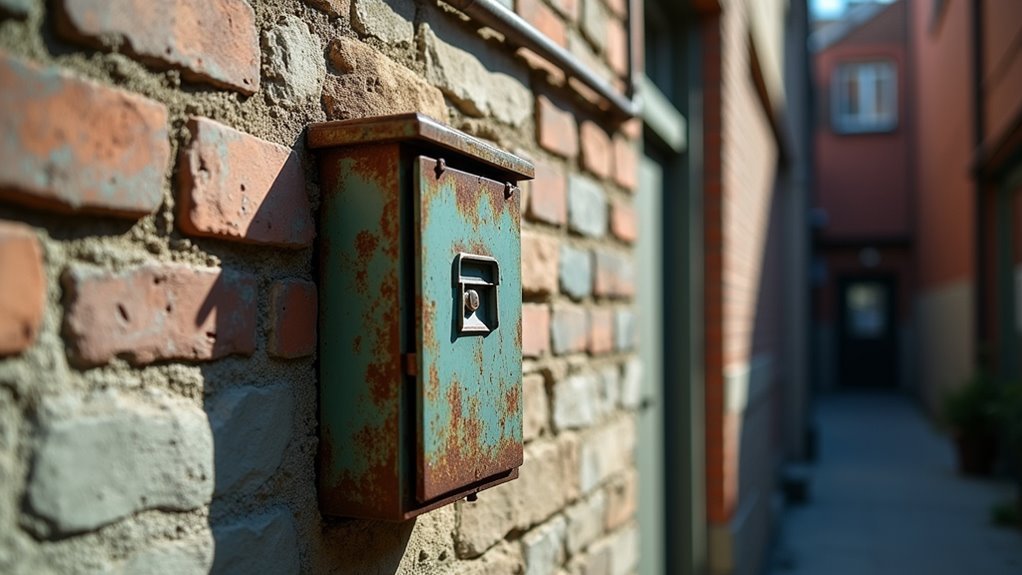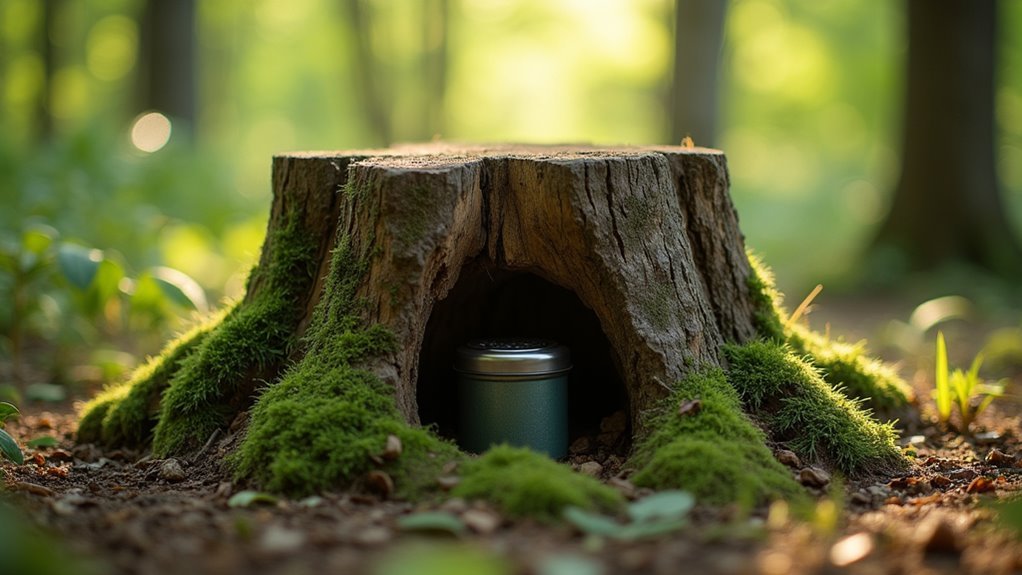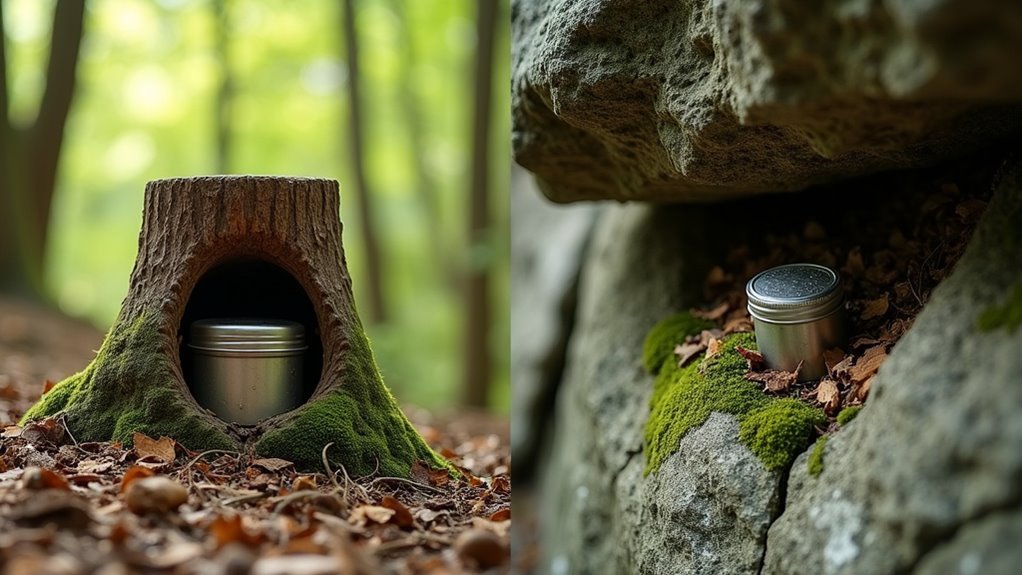Some of the links in this article may be affiliate links. If you make a purchase through these links, we may earn a small commission at no extra cost to you. Thank you.
I’ve hidden geocaches in bustling downtown alleys and remote mountain trails, but the thrill of concealment never gets old. When I’m planning a new hide, I think about that moment when a fellow cacher’s frustration suddenly transforms into delight at the discovery. Maybe you’re considering hiding your first cache, or perhaps you’re looking to up your game beyond the standard lamppost skirt. Either way, the art of the perfect hide is about to get more interesting.
Urban Environment Hiding Techniques

How do you hide something in plain sight when dozens or hundreds of people walk past it every day?
That’s the challenge of urban geocaching, where hiding spots require extra creativity.
I’ve found that boardwalk rails make excellent places to conceal a cache—CleverHides.com has this flip-out design that’s practically invisible until you know what to look for.
Look for boardwalk rails—they’re perfect for those flip-out designs that remain hidden until you’re in on the secret.
In my experience, urban caches work best when they mimic everyday features.
Try using a decoy container with a note directing to the real GPS coordinates, or create a fake bug on fungus for park settings.
I think the best urban hiding spots consider both concealment and durability.
You’ll want to test your cache against weather conditions, especially in high-traffic areas.
Natural Landscape Concealment Strategies
The natural world offers some of my favorite hiding spots for geocaches, where the landscape itself becomes your ally in concealment.
When I’m out with my GPS receiver, I love using trees and stumps as hiding spots—they’re perfect for blending containers seamlessly with their surroundings.
Before finalizing any spot, I always inspect it thoroughly, just as Rietje Swinnen suggests.
Will your container actually fit?
You’ve got to test your cache for weather durability too, especially when using the Geocaching Help Center guidelines.
I’ve found that creating deceptive elements, like placing a fake bug on fungus near your cache, confuses even experienced Adventure Lab enthusiasts with high-quality GPS units.
Focus on shorter trees or unique stumps—they’re easier to access but still provide that natural camouflage that makes geocaching such a thrilling outdoor pursuit.
Creative Container Disguises

Geocachers’ creativity truly shines when it comes to disguising containers in plain sight.
I’ve seen some incredible Project APE Cache-inspired disguises that’ll leave you puzzled for hours!
When discussing creating Adventures, remember that misdirection is key – like those decoy caches with notes redirecting seekers to the actual container nearby.
For puzzle writers looking for Adventure Lab inspiration tips, here are my favorite disguise techniques:
- Integration methods like the Flip-out Boardwalk Rail that blends seamlessly with existing structures
- Natural camouflage tricks such as attaching fake bugs to fungus (I actually couldn’t spot one of these for 20 minutes!)
- Deterrent disguises like Dollar Store fake snakes that make most geocachers think twice before reaching in
These container aspects of trackables make the hunt so much more exciting!
Seasonal and Weather-Resistant Hide Locations
Selecting durable hide locations becomes particularly critical as seasons change, and I’ve learned this lesson the hard way!
When I’m placing a cache near a GPS devices still accessible area, I always test its weather resistance first.
I mean, if it can’t withstand the next rainfall while following Adventure Lab Guidelines, what’s the point?
I’ve found that shorter trees or stumps make excellent hiding spots that align with the Help Center for Adventure Lab recommendations.
They provide natural protection while maintaining paperless caching and related functionality.
For Trackable inventory on cache placement, make sure your container fits snugly in its spot.
This prevents water damage during seasonal changes which is essential for the aspects of trackables maintenance.
The official Geocaching® apps won’t help you accomplish some geocaching-related task if your cache is waterlogged!
Beginner-Friendly vs. Challenge-Level Hiding Spots

When choosing where to hide a geocache, I’ve found that understanding the difference between beginner-friendly and challenge-level spots makes all the difference!
Choosing the right spot for your geocache creates experiences tailored perfectly for beginners or seasoned adventurers alike.
As developed by Geocaching HQ, there’s a place to discuss creating different difficulty levels that serve different audiences.
For those new to the game, I recommend focusing on:
- Natural fits like stumps or short trees where Cache wird nicht be too difficult to find
- Locations that prioritize visibility while still providing basic concealment
- Weather-resistant spots you’ve tested against rain and elements
Challenge caches, on the other hand, might incorporate deceptive elements—maybe a fake bug on fungus or hidden information inside the lid.
The Builder Guide also contains valuable tips for creating advanced hides where the inventory on cache logs might require more detective work.
It’s really about knowing your audience!
Frequently Asked Questions
Where to Hide a Geocache?
I’d hide my geocache under a bridge underside, by a cemetery corner, near a school yard, on a library shelf, under a statue base, inside a fence post, along a river bank, or behind a trail marker.
What Are Good Hide and Seek Spots?
I’ve hidden in backyard bushes, hallway closets, library stacks, and playground equipment. You’ll find beach dunes, forest thickets, school lockers, office cubicles, kitchen cabinets, and garage corners equally thrilling for concealment.
Why Is Geocaching Controversial?
I find geocaching becomes controversial when it causes environmental impact, trespassing issues, wildlife disturbance, and safety hazards. Legal restrictions emerge from community backlash over privacy invasions, cultural insensitivity, addiction concerns, and commercialization effects.
What Is a Ghost Geocache?
I’ve found that a ghost geocache is a deliberately elusive hide employing deception like decoys or unexpected hiding methods. The Definition Mysteries behind these Spectral Caches involve clever camouflage that’ll challenge even seasoned finders.